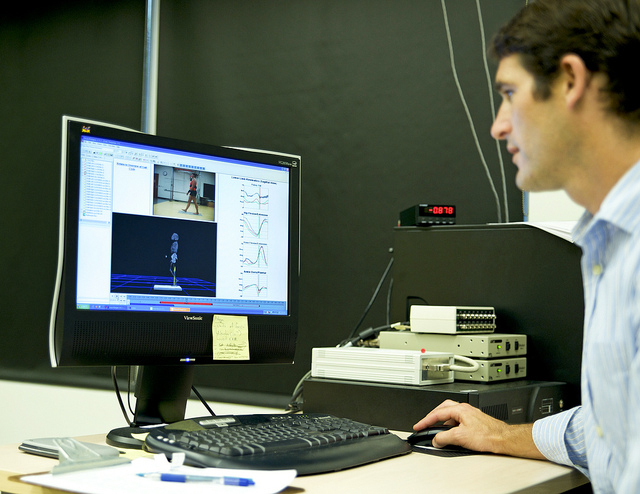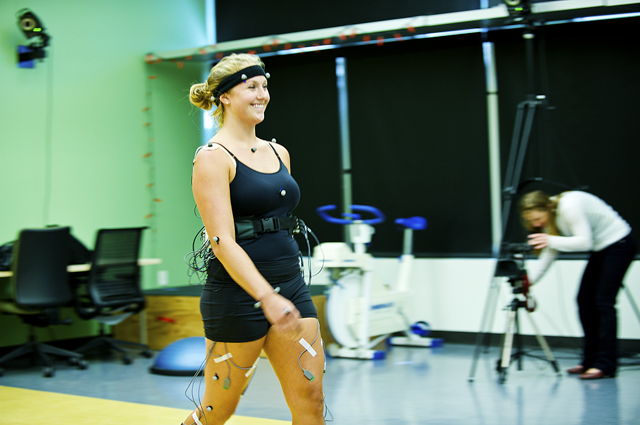
In the lab, Professor Justus Ortega and his students have access to computerized testing equipment and biomechanics technology that can be used to study the way the brain and body function. They hope to use those tools to study the way “normal” and concussed bodies act differently. And they’re hoping to see if refined, computerized data lines up with the idea behind walking the line.
Over a year ago, Ortega and former HSU Professor Anthony Kontos worked together to write a chapter for the 2011 book, “The Handbook of Sports Neuropathology.” Their collaboration covered the effects of concussion on mental function and balance while a person is standing or walking.
During his research, however, Ortega noticed that he had seen similar behavior from impaired people taking police sobriety tests. Essentially, the police are looking at a person’s ability to perform a physical task that requires balance, while also doing a mental task. “A drunk person basically can’t multitask,” Ortega says.
The impairments that he noticed are called lateral instabilities, and that—along with cognitive performance—is what the “HSU Johnny Cash test,” as Ortega dubs it, will look for. A person suspected to have a concussion would be asked to walk in a straight line. At the same time, he or she will be given neurocognitive tests, such as counting down in increments of seven and memory tasks. Each time they falter from the line, they will get an error added to their score. The hypothesis is that, a person suffering from a concussion will receive many more errors walking the line than he or she would if uninjured.
This new assessment can potentially be used to help diagnose athletes on the sidelines, soldiers and anyone suspected of suffering from a mild traumatic brain injury. But to be used, it first has to be proven effective. In order for that to happen, students working with Ortega are researching the relationship between lateral instability and neurocognitive ability in both uninjured and concussed individuals.
Currently, the coordinator of the concussion program, Beth Larson, gives all student athletes at HSU an Immediate Post-Concussion Assessment and Cognitive Testing, called an ImPACT test, during the pre-season. The 20-minute, computerized test is a standard and effective tool in sports from the middle school to professional levels. It is used to evaluate thinking and reasoning skills, including attention span, reaction time and memory.
This baseline data is used to determine how an athlete functions normally and is used for comparison if a concussion is suspected during the season. Students, faculty, staff and community members are also invited to take the neurocognitive test to provide additional “normal,” or non-concussed data.
After a head injury, an athlete is referred to the concussion program by his or her trainers for a follow-up evaluation. The ImPACT test is administered again, and the results are compared to the baseline to see if and how the student is affected.

With the player’s consent, he or she can also participate in a gait analysis test. For the analysis, athletes are suited with marker balls to help gauge their balance while walking in a straight line. When a person falters in the gait analysis, they get an error score. A baseline for “normal” error scores is drawn from data collected from non-concussed students, faculty, staff and community members as well.
By looking at the error scores of concussed athletes, measured against their baseline cognitive data and the error scores of uninjured people who have walked the line, Ortega and his students hope to determine whether the results of their new test correlate well with the results that their lab equipment can produce.
A strong correlation would mean that further research could be conducted and, once the “Johnny Cash” test is approved for human testing, data on its effectiveness can start being collected.
Last fall, Ortega worked with students to conduct a series of pilot studies, which helped them refine the testing questions and tasks to be asked of the person walking the line. This fall, they hope to begin testing the effectiveness of their sideline test against the results from their state-of-the-art lab. Ortega also hopes to collaborate on the research with Kontos, who is now in the Department of Orthopaedic Surgery at the University of Pittsburgh.
“Our goal, by the end of the academic year, is to get a grant and start expanding on our research,” Ortega says. “I’m waiting for the day I hear a sportscaster announce the ‘HSU Johnny Cash’ test during NFL football.”
For more information on the North Coast Concussion Program or The Johnny Cash study, please contact Beth Larson, Coordinator, NCCP at (707) 826-3533 or Dr. Justus Ortega in the Biomechanics Lab at (707) 826-5973.
For more information on the ImPACT Test, visit “impacttest.com”:http://impacttest.com/.